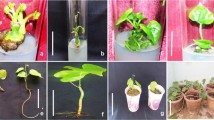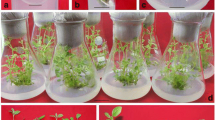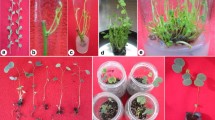Abstract
Shoot-tip explants of Rheum emodi Wall. (Polygonaceae) gave rise to multiple shoots when cultured on a Murashige and Skoog (1962) medium (MS) with 2.0 mg/l 6-benzylaminopurine (BAP) and 1.0 mg/l indole-3-butyric acid (IBA). Also, shoot buds developed from leaf explants using MS medium with 2.0 mg/l BAP and 0.25 to 1.0 mg/l indole-3-acetic acid (IAA) or IBA. Roots were induced when the resulting shoots were placed on MS medium with 1.0 mg/l IBA. Both regeneration procedures gave rise to healthy plantlets that were established in soil under glasshouse conditions at 80% frequency after hardening phase of two weeks. Regenerated plants showed a constant chromosome number of 2n=2x=22, same as the parent plant. The use of liquid shake cultures minimized the time and culture medium requirements for propagation. This procedure can be applied for the conservation and utilization of elite clones of R. emodi.
Similar content being viewed by others
Abbreviations
- BAP:
-
6-benzylaminopurine
- Dd H2O:
-
Double glass distilled water
- IAA:
-
indole-3-acetic acid
- IBA:
-
indole-3-butyric acid
- K:
-
Kinetin
- MS:
-
Murashige and Skoog's (1962) medium
- RH:
-
Relative humidity
References
Anonymous (1972) The Wealth of India, Vol.IX, Chadha YR (ed.) Press and Information Directorate, CSIR, New Delhi, pp. 3–6.
Biondi S, Thorpe TA (1981) In: Thorpe TA (ed.) Plant Tissue Culture: Methods and applications in Agriculture, Academic Press, New York, pp.1–20.
Bohanec B (1985) Fagopyrums: 13–15.
Chopra RN, Chopra IC, Handa KL, Kapur LD (1958) Chopra's Indigenous Drugs of India (2nd edn.) UN Dhar and Sons Pvt. Ltd., Calcutta, pp. 233–236.
Ghouse M (1935) J Ind Inst Sci. IBA: 134–135.
Ghouse M, Katti MCT (1933) J Ind Inst Sci 16A: 1–9.
Hoagland DR, Arnon D (1950) Calif Agric Stn Circ 347.
Levine R, Gaba V, Hirsh S, Denola D, Vasil IK (1988) Bio/Technology 6: 1035–1040.
Majumdar N, De NK (1938) Ind J Med Res 25: 671–675.
Murashige T, Skoog F (1962) Physiol Plant 15: 473–497.
Okabe HK, Matsoo K, Nishioka I (1973) Chem Pharm Bull 21: 1254–1260.
Roggemans J, Claes MC (1979) Sci Hortic 11: 241–246.
Shah NC (1983) In: Jain SK and Rao RR (ed.) An assessment of Threatened Plants of India, BSI, Howrah, pp. 40–49.
Srejovic V, Nescovic M (1981) Z Pflanzenphysiol 104: 37–42.
Walkey DGA (1968) J Hort Sci 43: 283–287.
Walkey DGA, Mathews KA (1979) Plant Sci Lett 14: 287–290.
Author information
Authors and Affiliations
Additional information
Communicated by J. M. Widholm
CIMAP Publication No. 876
Rights and permissions
About this article
Cite this article
Lal, N., Ahuja, P.S. Propagation of Indian Rhubarh (Rheum emodi Wall.) using shoot-tip and leaf explant culture. Plant Cell Reports 8, 493–496 (1989). https://doi.org/10.1007/BF00269057
Received:
Revised:
Issue Date:
DOI: https://doi.org/10.1007/BF00269057




